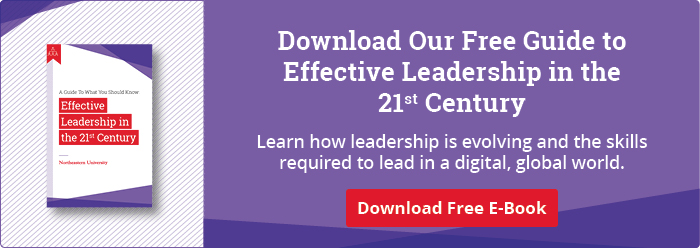Today’s HR professionals and executives cite leadership development as a major human capital challenge and recognize that “developing leaders within organizations is critical to business success.” As such, employers are seeking employees with leadership skills at all levels, from the CEO to individual contributors.
“There are leadership experiences needed in virtually all aspects of business,” says Rita Balian Allen, a Northeastern University lecturer and one of Boston Women’s Business Journal’s “Top Ten Executive Coaches.” “Leadership isn’t necessarily about managing. It’s about having a vision and being able to influence people. It’s taking an idea or a concept and bringing it alive. Everyone has the potential to unleash and nurture these skills.”
Although there’s no one-size-fits-all leadership style, there are some tried and true methodologies that have worked for some of today’s most effective leaders. Learn more about five common leadership styles and how you can make them your own.
Download Our Free Guide to Effective Leadership in the 21st Century
Learn how leadership is evolving and the skills required to lead in a digital, global world.
Five Common Leadership Styles
Common leadership styles employed today include:
1) Transformational Leadership
These highly influential leaders serve as role models to inspire others. Defined by leadership studies scholars Bruce Avolio and Bernard Bass, this leadership style involves improving the morale and job performance of team members by connecting with their sense of identity and the collective identity of the organization. A transformative leader is a visionary who inspires others and encourages critical thinking and innovation. Examples of transformational leaders include politicians like Winston Churchill and business visionaries like Steve Jobs.
2) Participatory Leadership
Leaders who employ this hands-on style seek to bring a more democratic dimension to management instead of utilizing a traditional top-down approach. This leadership style recognizes that employees are stakeholders in the organization and are entitled to their own voice. Participatory leaders empower employees who will be most affected by certain decisions to have participation and/or decision-making capabilities in addressing those issues.
Former Southwest Airlines CEO James F. Parker embodied this style of leadership when he put the needs of his employees first after the 9/11 attacks. Instead of cutting back staff like other airlines were doing at the time, he initiated a profit-sharing program.
3) Value-based Leadership
Value-based leaders guide their teams by encouraging others to act in accordance with the organization’s shared core values. Instead of focusing exclusively on metrics, values-based leadership drives positive change by emphasizing the organizational mission and purpose. This means having a leader who “walks the talk” and upholds the founding principles of the organization. This type of leader is driven by his or her core values which are modeled and aligned with company values.
APJ Abdul Kalam, former president of India and one of the country’s best-known scientists, followed this leadership style. His personal and work ethics served as a model to inspire others in the development of the world-class Indian Space Research Organization.
4) Situational Leadership
This model was developed by business consultant and bestselling author Ken Blanchard and behavioral scientist Paul Hersey. It is a framework for leaders to match their behaviors to the performance needs of those they are working to influence. The Center for Leadership Studies explains that situational leaders must have the ability to:
- Diagnose an individual’s performance readiness to complete a specific task
- Adapt leader behavior based on the diagnosis
- Communicate an influence approach in the manner that followers can both understand and accept
- Advance by making the move toward higher performance
A notable example of a leader who practiced situational leadership is former NBA Coach Phil Jackson, who managed his team based on their individual strengths, weaknesses, and motivations.
5) Servant Leadership
Servant leaders enrich the lives of others by focusing on building better organizations and ultimately creating a world that is more caring and equitable. First coined by Robert K. Greenleaf, the term servant leader refers to a person who makes a conscious decision to aspire to lead in a way that places other people’s needs as their highest priority. The servant leader dedicates himself or herself to the growth and well being of people in the community. Instead of focusing on accumulating power, this leader shares power and helps others perform as highly as possible.
There have been many studies indicating organizations that are servant-led perform better and yield higher returns. Well-known advocates of this style of leadership include Ken Blanchard, Steven Covey, and Larry Spears.
How to Choose the Right Leadership Style for You
You may gravitate toward one leadership style, based on your innate strengths or aspirations; however, you don’t need to feel boxed into one style. “There’s no one ideal way to lead,” explains Balian Allen. “There is no ‘right’ style. One leader might be charismatic and inspire others while another might excel at developing teams.”
To be a good leader, she says, you really just have to be agile. You may even practice different leadership styles in different situations, depending on who you’re leading and the challenge at hand.
“Knowing what makes you shine and being able to build on that empowers you to adjust your style and approach depending on your audience while staying true to yourself. You want to be flexible, but to stay authentic to who you are. If you’re authentic as a leader, people will believe in you.”
“Being a good leader means knowing yourself really well,” she adds. “This requires a lot of personal due diligence. You need to really think about who you are and what makes you tick. Think about your values, what you’re good at, and what your limitations, goals, and aspirations are. These are important steps to building your personal brand as a leader. To market yourself, you need to be a good storyteller of what you’ve achieved so you can seize new opportunities to position yourself and what you have to offer. In order to lead others, we have to first be able to lead ourselves, and this takes ongoing reflection and growth to heighten our self-awareness.”
Although leadership styles can differ, Balian Allen says there are certain universal skills that most effective leaders share which aspiring leaders should strive to develop.
Core Leadership Skills
In their book, The Leadership Challenge, James Kouzes and Barry Posner studied hundreds of exemplary leaders and found there were five practices they shared in common. Effective leaders:
- Model the way: Create standards of excellence to set an example for others to follow
- Inspire a shared vision: Show people the possibilities for the future
- Challenge the process: Experiment and take risks to make meaningful improvements
- Enable others to act: Actively empower people to strengthen the whole team
- Encourage the heart: Celebrate the accomplishments of others
By implementing these practices, you can strengthen your own skills as an organizational leader.
Surprising Leadership Qualities Across Styles
Being an effective leader isn’t just about your own actions, however. It also requires a deep understanding of others. That’s why it’s important for leaders to embody these additional (and possibly surprising) qualities, no matter the leadership style you choose.
Compassion
Many of today’s most effective leaders practice compassion for others. In a remarkable keynote address to Wharton University students, LinkedIn CEO Jeff Weiner spoke frankly about his lack of compassion as a young professional, the realization he needed to change, and his aspiration to manage compassionately. A journalist once described Weiner’s management style while at Yahoo as though he were “wielding his fierce intelligence as a blunt instrument.” He later realized how unproductive this approach was and worked to develop a culture of compassionate ethos. He went on to create a work environment where people took the time to understand each other’s point of view, build trust, and align a shared mission.
“If you show compassion and are transparent—even in difficult situations—people are more likely to give you their support,” explains Balian Allen.
Emotional intelligence (EQ)
“The most powerful competency [in leadership] is empathy,” says Balian Allen. “If you are able to develop your emotional intelligence, you can influence others most effectively. People who have strong emotional intelligence are socially aware and are able to read the mood of a room and understand interpersonal dynamics. It’s been said that 80 percent of communication is nonverbal, so it’s important to listen beyond the words, pay close attention to others, and to read the cues. EQ is all about identifying, understanding and managing emotional information in oneself and others, building strong relationships, and influencing effectively.”
(Balian Allen also suggests leaders read more about the theory of EQ and related studies in Daniel Goleman’s book, Primal Leadership: Learning to Lead with Emotional Intelligence.)
Vulnerability
“There is a myth that as a leader you have to be stoic and you have to be infallible,” says Balian Allen. “It’s ok to say you don’t know something or you tried something and failed. That takes great strength. There is actually no such thing as failure…Sometimes our best lessons are through mistakes we’ve made—and those learning experiences make us stronger and wiser.”
Invest in Your Leadership Skills
Balian Allen explains the importance of being deliberate about your own leadership development:
“Good leaders are lifelong learners. They are always growing. You have to be really strategic and thoughtful about working on yourself and creating a plan.”
Even seasoned leaders benefit from self-reflection and assessment. 360-degree feedback processes are one way to step back and gain feedback from other leaders, direct reports, and stakeholders about how you’re doing and where you can continue to grow.
“This is an ongoing process that’s needed for growth, no matter what your discipline is,” explains Balian Allen. “It’s a way to push yourself out of your comfort zone and continuously seek ways to further develop and grow as a leader.”
Enrolling in an advanced degree program is one highly effective way to gain leadership skills to grow your career. An MS in Leadership can arm you with the knowledge, frameworks, and skills to cultivate a personal leadership philosophy. Through real-world lessons, you can build and strengthen your leadership capabilities.
Looking for more information on how to develop your leadership skills to advance your career and organization? Download our free guide below.
Rita Balian Allen is the president of Rita B. Allen Associates, a national career management firm specializing in executive coaching, leadership development, management training, and career development. Rita is a lecturer at Northeastern University, a sought after speaker, author of numerous articles, blogs, and the book, “Personal Branding and Marketing Yourself”. She holds an MS in Leadership, BSBA, and is a PCC and Advanced Certified Personal and Executive Coach. Rita was voted one of top ten executive coaches by Boston Women’s Business Journal.







Related Articles
5 Practices of Exemplary Leaders
Master’s Degree Comparison: Sports Leadership vs. Sports Management
How to Become a Sports Administrator